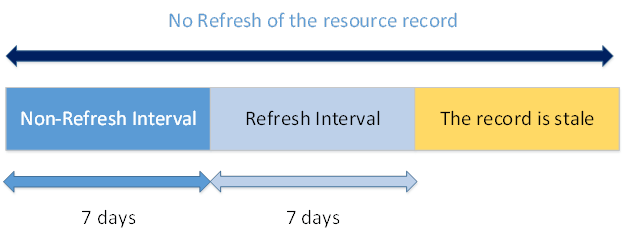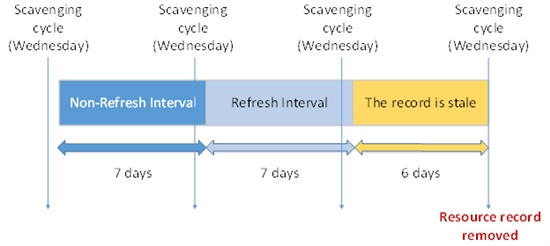DNS Aging and Scavenging
What is Aging and Scavenging in DNS
Aging and Scavenging is an interested topic in DNS and its more important to know about DNS Aging and Scavenging services. Aging and Scavenging is a DNS server service which supports a mechanism for performing clean-up and removal of stale resource records which can accumulate in zone data over time. It helps to maintain the dynamic DNS environment by regular deletion of stale resource records from the DNS database. Some problems associated with stale records are: unnecessary space utilization long zone transfers, wrong resolution of the client query due to stale data, and accumulation of stale records on the DNS server can degrade its performance. These stale records problems can be resolved by the aging and scavenging features. Before using aging and scavenging features of DNS some conditions needed are:
1) Aging and scavenging features must be enabled on the DNS server and on the zone. By default, they are not enabled.
2) Resource records must be added dynamically to the zone or manually modified to be used in operations of aging and scavenging.
Aging
Aging is the process of identifying stale DNS records. It uses two intervals:
1) Non-Refresh interval
2) Refresh interval
Non-Refresh interval
This is the time period in which the resource records cannot be refreshed. It can be used to reduce the replication traffic in this time period to avoid the replication of the same information again.
Refresh interval
This is the time period in which the resource records can be refreshed.
Resource record refresh: This is a DNS dynamic update without changing the hostname and IP address.
If the non-refresh interval and refresh interval are 7 days, then the resource records can be considered as stale if not refreshed after 14 days. If the non-refresh interval and refresh interval are elapsed, then the resource records can be refreshed as long as they are not removed from the DNS zone. Aging uses a resource record time-stamp to identify if the record is stale or not.

Resource records having timestamp zero: These records are static records that are not stale records.
Resource records having timestamp not equal to zero: These records are dynamic records which represent the hour of the last refresh date.
Scavenging
Scavenging is the process of removal and clean-up of stale resource records from the DNS zone. The stale resource records will be removed only if the scavenging is enabled on the resource record, where the resource record exists and at least one DNS hosting where the primary copy of the resource records exists.
Scavenging can be set in three places:
1) Individual record
2) Zone
3) Server
If scavenging is set on zone it will work only for dynamic records. It will work for manual entries only if it’s enabled for the zone. Once scavenging is set on zone this will enable it on DNS servers. The DNS server where the scavenging option enabled is responsible to scavenge the record. The server will log a DNS event 2501 to indicate the number of scavenging record and it will log a DNS event 2502 if no record where scavenged.
Scavenging formula:
Record timestamp+no refresh interval for zone+refresh interval for zone
If the sum of these values are greater the server time (current date and time on the DNS server) no action is taken and records are not deleted from the zone. If the sum is less than server time the records are deleted.
Aging and scavenging process for a sample record
If scavenging occurs every Wednesday on a DNS server, Non-Refresh and Refresh intervals are equal to seven (7) days for each and the last refresh of the DNS record occurred on a Thursday then the resource record will be removed in the scavenging cycle of the week number four (4).

Note- Scavenging occurs on recurring interval when enabled on a DNS server. A stale resource record can then still exist until the next cycle of DNS scavenging.
So, that’s all in this blog. I will meet you soon with some other stuff. Have a nice day !!!
Recommended content
RODC Installation Guide- Step by step guide to install read only domain controller
RODC Filtered Attribute Set
Installing and configuring a RODC in Windows Server-2012
How to find the GUID of Domain Controller
Group Policy Understanding Group Policy Preferences
Group Policy Verification Tool GPOTool Exe
Group Policy Health Check on Specific Domain Controller
What is Netlogon Folder in Active Directory
How to Create Custom Attributes in Active Directory
How Can I Check the Tombstone Lifetime of My Active Directory Forest
How to Determine a Computers AD Site From the Command Line
How to Check the Active Directory Database Integrity
How to Check the Active Directory Database Integrity
Disabling and Enabling the Outbound Replication
DFS Replication Service Stopped Replication
What is Strict Replication Consistency
The replication operation failed because of a schema mismatch between the servers involved
Troubleshooting ad replication error 8418 the replication operation failed because of a schema mismatch between the servers
How to export replication information in txt file
Repadmin Replsummary
Enabling the outbound replication
Guys please don’t forget to like and share the post. You can also share the feedback on below windows techno email id.
If you have any questions feel free to contact us on admin@windowstechno.com also follow us on facebook@windowstechno to get updates about new blog posts.
